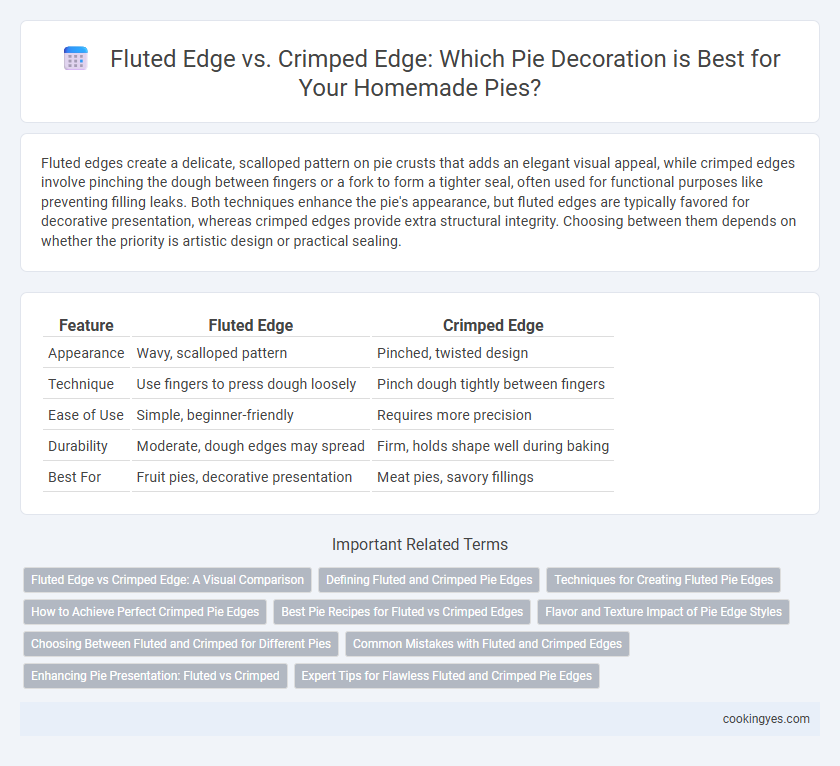Fluted edges create a delicate, scalloped pattern on pie crusts that adds an elegant visual appeal, while crimped edges involve pinching the dough between fingers or a fork to form a tighter seal, often used for functional purposes like preventing filling leaks. Both techniques enhance the pie's appearance, but fluted edges are typically favored for decorative presentation, whereas crimped edges provide extra structural integrity. Choosing between them depends on whether the priority is artistic design or practical sealing.
Table of Comparison
| Feature | Fluted Edge | Crimped Edge |
|---|---|---|
| Appearance | Wavy, scalloped pattern | Pinched, twisted design |
| Technique | Use fingers to press dough loosely | Pinch dough tightly between fingers |
| Ease of Use | Simple, beginner-friendly | Requires more precision |
| Durability | Moderate, dough edges may spread | Firm, holds shape well during baking |
| Best For | Fruit pies, decorative presentation | Meat pies, savory fillings |
Fluted Edge vs Crimped Edge: A Visual Comparison
Fluted edges create a wavy, scalloped pattern around the pie crust, offering a delicate and decorative finish that highlights the pie's homemade charm. Crimped edges, on the other hand, feature a pinched design made by pressing the dough between fingers or with a fork, providing a sturdier seal that helps prevent filling leakage during baking. Both techniques enhance crust texture and visual appeal, but fluted edges are often preferred for aesthetic elegance while crimped edges prioritize functionality and a traditional look.
Defining Fluted and Crimped Pie Edges
Fluted pie edges feature a series of rounded, wave-like indentations created by pinching the dough between fingers to form a consistent pattern, often giving pies an elegant and classic appearance. Crimped pie edges involve pressing the dough between the thumb and forefinger or using a fork to create a tighter, more pronounced seam that helps secure the pie crust while adding texture. Both fluted and crimped edges not only enhance the pie's decorative appeal but also play a functional role in sealing the crust and preventing filling leakage during baking.
Techniques for Creating Fluted Pie Edges
Fluted pie edges are created by pinching the dough between the thumb and forefinger to form a repetitive ripple pattern that enhances both texture and aesthetics. This technique requires even dough thickness and consistent pressure to achieve a uniform, elegant ruffled effect along the crust's rim. Using cold dough and a gentle touch helps maintain the fluted shape during baking, ensuring a visually appealing, professional-quality pie crust.
How to Achieve Perfect Crimped Pie Edges
Achieving perfect crimped pie edges involves pinching the dough between your thumb and index finger while pressing with the opposite hand's index finger to create uniform, decorative ridges. Chilling the dough before shaping helps maintain structure and prevents shrinking during baking, ensuring crisp, well-defined crimps. Using consistent pressure and spacing along the edge enhances the pie's visual appeal and improves sealing to keep fillings intact.
Best Pie Recipes for Fluted vs Crimped Edges
Fluted edges create an elegant, scalloped appearance that enhances presentation and works well with delicate fruit pies like apple or cherry, where a refined crust adds aesthetic appeal without overpowering the filling. Crimped edges offer a secure seal and rustic charm, ideal for savory pies such as chicken pot pie or hearty beef and vegetable pies, ensuring the filling stays locked in during baking. Best pie recipes for fluted edges favor tender doughs like pate brisee, while crimped edge recipes often use sturdier, more pliable pastry doughs that hold shape under pressure.
Flavor and Texture Impact of Pie Edge Styles
Fluted edges create a delicate, crispy texture that enhances the pie's overall crunch, while crimped edges offer a denser, chewier bite that seals in moisture and intensifies flavor. The fluted edge allows for more even browning and a lighter crust experience, whereas the crimped edge promotes a tightly sealed pie, preserving juiciness and rich filling aromas. Choosing between fluted and crimped edges significantly influences the balance of texture contrast and flavor retention in fruit and custard pies.
Choosing Between Fluted and Crimped for Different Pies
Fluted edges create a scalloped pattern ideal for delicate fruit pies, enhancing both visual appeal and even baking by preventing dough from shrinking. Crimped edges provide a tighter seal commonly used for custard or meat pies, ensuring filling stays secure during cooking. Selecting between fluted and crimped edges depends on the pie type, with fluted edges favoring decorative presentation and crimped edges prioritizing functionality.
Common Mistakes with Fluted and Crimped Edges
Common mistakes with fluted edges include uneven pressure application, causing irregular patterns that detract from the pie's aesthetic appeal. Crimped edges often suffer from inconsistent pinching, leading to gaps that can leak filling during baking. Ensuring uniform technique and steady hand movements is essential for achieving clean, decorative pie edges.
Enhancing Pie Presentation: Fluted vs Crimped
Fluted edges create a decorative, scalloped finish that enhances pie presentation by adding elegant texture and visual appeal, often achieved with a fork or specialized pie crimper. Crimped edges offer a classic, rustic look by pinching the dough between fingers or tines, providing a secure seal that prevents filling leakage while giving the pie a homemade charm. Choosing between fluted and crimped edges depends on the desired aesthetic and functional preference, with fluted edges favored for formal presentations and crimped edges for traditional comfort.
Expert Tips for Flawless Fluted and Crimped Pie Edges
Expert tips for flawless fluted pie edges emphasize using your thumb and index finger to pinch the dough gently, creating even, scalloped patterns while ensuring the crust is chilled to prevent shrinking. For crimped edges, pressing the dough with a fork or pinching with fingers evenly seals and adds decorative appeal, with consistent pressure critical to avoid uneven baking. Mastering these techniques preserves the pie's structure and enhances its visual appeal, resulting in beautifully finished pies that bake evenly and hold their shape.
Fluted edge vs crimped edge for pie decoration Infographic

 cookingyes.com
cookingyes.com